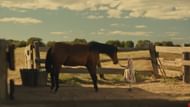Set in the 1859 Arizona Territory, Killing Faith follows Sarah (DeWanda Wise), a freed slave determined to protect her young daughter from a world that fears her mysterious ability to bring death with a touch. Haunted by fear and superstition, Sarah’s desperate search for help leads her to Dr. Bender (Guy Pearce), a skeptical doctor, and the preacher Ross (Bill Pullman), whose brand of faith veers into fanaticism. Their intertwined journeys explore belief, loss, and the human need to find meaning in suffering.
Disclaimer: This article contails major spoilers for the ending of Killing Faith. Reader's discretion is advised.
By the time the story reaches its final breath, the answer to what was buried becomes clear: it is faith itself. The film’s haunting conclusion reveals that conviction, when pushed to its extreme, can be as destructive as any curse. The girl’s power may never be explained, but its impact exposes how belief, whether in God, science, or redemption can drive people to sacrifice everything. In that final moment, what dies is not innocence, but the blind trust that faith alone can save anyone.
The cost of belief in the Killing Faith ending
 Dr. Bender seeks answers from the preacher, capturing the moral conflict at the heart of Killing Faith. (Image via Shout! Studios)
Dr. Bender seeks answers from the preacher, capturing the moral conflict at the heart of Killing Faith. (Image via Shout! Studios)The ending hinges on a brutal sacrifice. When Sarah realizes that the preacher’s cure demands her daughter’s death, she hesitates for the first time. Faith, she learns, can become a weapon when wielded by the wrong hands. Ross insists the child must die to cleanse the land, while Bender argues that the real curse is ignorance.
Dr. Bender, who has long clung to reason, steps in to prevent the ritual, setting off a violent struggle that leaves both the preacher and Bender shattered. The film’s closing scenes, as described by critics, emphasize ambiguity rather than spectacle. Some interpret Bender’s suffering in the desert as penance for his disbelief, while others see it as a symbolic redemption.
This moral ambiguity deepens Killing Faith beyond genre convention. The Western often glorifies clear heroes and villains, yet Crowley’s vision resists that simplicity. Each character clings to a version of faith, religious, scientific, or emotional, and the ending exposes how all can fracture under pressure. Sarah’s maternal devotion mirrors Ross’s blind conviction, and both contrast with Bender’s struggle to reconcile logic with loss. No one escapes untouched. The ambiguity forces viewers to decide which kind of faith is worth dying for.
The nightmare vision and its hidden symbols
 The young girl reaches out to a horse in a quiet moment that contrasts innocence and danger in Killing Faith. (Image via Shout! Studio)
The young girl reaches out to a horse in a quiet moment that contrasts innocence and danger in Killing Faith. (Image via Shout! Studio)The surreal visuals of the final sequence heighten its emotional charge. As the ritual spirals out of control, the film unleashes a series of haunting images: bodies in strange configurations, fires in the distance, the little girl’s trembling hand suggests an apocalypse born from human fear.
Each image feels symbolic, like a fever dream that straddles death and rebirth. The burning cross behind Ross’s final sermon evokes purification but also destruction, a commentary on how belief can consume the believer. The desert, filmed in golden light by cinematographer Justin Hamilton, becomes both tomb and altar, a place where truth dies but memory lingers.
Bender’s final hallucination, of his deceased daughter standing unharmed in the desert, serves as emotional closure without narrative certainty. Is he dying, dreaming, or witnessing the miracle Sarah prayed for? Crowley never clarifies, and that silence turns meaning into an act of personal interpretation. The ending’s imagery reflects the duality of faith itself: it can heal, or it can kill, depending on who holds it.
Open questions that define Killing Faith
 The girl crouches in the river, a haunting image that reflects purity, danger, and rebirth in Killing Faith. (Image via Shout! Studios)
The girl crouches in the river, a haunting image that reflects purity, danger, and rebirth in Killing Faith. (Image via Shout! Studios)Even after the credits roll, Killing Faith refuses resolution. Did the girl truly possess supernatural power, or did fear create the illusion of one? Was Ross a prophet or a predator exploiting hysteria? And most haunting of all, did Bender’s final act end the curse, or simply pass it on? These questions echo long after the story ends, feeding into the film’s critique of certainty itself. Crowley’s script positions faith not as comfort but as confrontation. It asks what happens when truth is unknowable and belief becomes the only way to survive.
In Killing Faith’s closing moments, Sarah walks away from the ruins, her daughter’s fate uncertain. The camera lingers on the horizon, vast, blinding, and empty. It’s an ending that feels like a question mark carved into the desert floor. The film doesn’t seek to explain the curse; it wants to expose the cost of clinging to one. By blending Western realism with spiritual horror, Killing Faith transforms its bleak finale into a meditation on the human need to find order in chaos.
The ending of Killing Faith is not about tying loose ends but about embracing discomfort. It leaves viewers questioning whether salvation and destruction are two sides of the same coin. That lingering uncertainty, that space between belief and reason, is where the film finds its soul. It doesn’t end with an answer. It ends with a whisper: some truths are meant to stay buried.
Why did you not like this content?
- Clickbait / Misleading
- Factually Incorrect
- Hateful or Abusive
- Baseless Opinion
- Too Many Ads
- Other
Was this article helpful?
Thank You for feedback
About the author
Edited by Urvashi Vijay More

.jpg) 2 hours ago
2
2 hours ago
2

 English (US)
English (US)